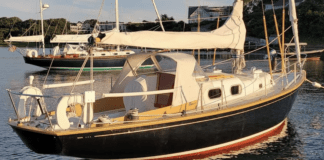
I was reading a Mailport letter in the December 2014 issue of Practical Sailor, and it led me to your May 27, 2014 blog regarding keel failure. We have a 1977 Islander 28 with a bolted-on fin keel that is creating a safety issue. I am confident I know what the proper repair is (remove the keel and re-secure it), but I am more wondering if youve ever seen anything like this. On the starboard side of the keel, below the keel joint, a square chunk of lead is bulging out of the keel side. Ive had a few surveyors take a look at it, and theyve never seen anything like it either. The keel bolts do not leak-at least water doesn’t come in. Thoughts?
Michelle Shrider,
CMM, General Manager
Washburn Marina
Islander 28
Washburn, Wisc.
It could be a case of steel keel bolts expanding, but like most domestic production boats of that era, the Islanders have lead ballast and 304-stainless-steel keel bolts. On most boats, these were held in place by a stainless plate that was embedded in the keel. During construction, the plate had to be heated so that the lead being poured did not cool too quickly around the keel-bolt weldment. Lead thats cooled too quickly will not become part of a uniform casting, and the crystallized boundary can easily shear, even separate from the casting. If this happens in the region where keel bolts are joined in a weldment, this can be a very structurally significant problem.
Try to find out which casting company (Mars or other) made the keel and how the bolts were embedded. If they used a stainless plate, were willing to bet it cooled too quickly or was never heated. Also, there looks to be a pretty good smack on the keel, and the resulting side load could have exacerbated the problem.
This can also happen when a J bolt is too close to the skin and a similar thermal reaction-where hot lead meets relatively cool stainless bolts-occurs.
We suggest digging into the area around the sheared lead to see whats going on. Even if the keel is removed, youll still want to see whats happening under the separating lead.








































